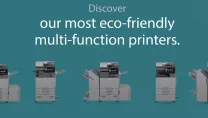As we look to 2023, we should remember that the last 12 months have not been without issues and concerns. One of the biggest issues this year has been the Russia/Ukrainian war, which has added massively to inflationary pressures. The energy crisis and the cost implications of that have caused ripples across manufacturing and end users alike – not only in Europe but around the world.
On one side there is the cost to manufacture, build and ship products, which requires materials and energy. For the end user, the cost of buying and then running devices has also become a lot more expensive.
Beyond energy, the supply chain remains fragile. The situation has improved but there is still uncertainty around supply chain continuity. Furthermore, as we emerge into a post-pandemic world of commerce countries are still living with the legacy of the money that governments had to spend just to underpin businesses throughout that period. All these pressures will have an impact on the spending power of the public sector.
Against this backdrop of pressures and pain points for businesses and manufacturers alike, there looms the worsening environmental condition for which there is an understanding that while the cost of doing something is high, the cost of doing nothing is equally high, so we must push forward and find new ways of working.
Continuing to support hybrid working with print
A year on from the pandemic many businesses have settled into a cadence of hybrid working. They have made decisions around what hybrid working means for them, and how best to use it to drive productivity and efficiency, while delivering a smarter work/life balance for employees. As a result, the economic pressures we currently face will continue to drive hybrid working adoption, giving businesses greater flexibility with their cost base.
From a print perspective, Sharp supports hybrid working as our devices are designed to connect into cloud platforms. It is the cloud that facilitates hybrid working via for example data sharing. Whether that is Microsoft Teams, Google Drive, OneDrive, SharePoint, Box, Sharp devices are a gateway to those platforms our customers use.
When it comes to the physical side of printing, we launched our Synappx Go application which is now natively supported with our new generation of A3 devices and supports contactless and remote mobile printing.
During the pandemic, many organisations delayed decisions to renew printing devices and contracts. We supported such initiatives by extending agreements but now many are looking to renew contracts and services while at the same time ride out the current economic downturn. As a result, a trend we expect to see through 2023 and beyond is opting for A4 rather than A3, as this reduces cost.
For Sharp, we believe it's important we can deliver the same experiences on an A4 device as on our next-gen A3 MFPs. This means not only the same user experience, but also the same IT experience because that supports efficiency and productivity and getting the best value from those devices.
Delivering secure workplace solutions via print
Security will always be a key priority for businesses regardless of size. Especially as the bar around security is constantly being raised. No matter how smart the securities are built into devices, the bad actors will always try and find something smarter. As a result, manufacturers and developers are constantly playing catch up.
Bad actors will always look for the easiest point of entry. Whether that is seeking vulnerabilities that have not been secured properly, or lack the latest patches, or through brute force such as DDoS attacks.
As a result, everything in your business needs to be secure. However, one area that continues to be overlooked is print. This may be because customers don't truly appreciate the vulnerability of print. Similarly, many Managed Service Providers (MSPs) fail to look at print as a vulnerability, largely because they don't see print as part of their scope of responsibility. However, like any connected device, print is an endpoint, so needs to be protected.
Part of our ongoing responsibility as a vendor is to inform and educate our customers around the issues, threats, and vulnerabilities of print security.
Sharp is in a fortunate position that we can offer a much broader range of IT consultancy, including security consultancy around and beyond print. Where we have those IT consultancy and services available, we absolutely ensure that our print security is included.
When it comes to security, we take a layered approach, looking at it from both a physical and a digital perspective. The device itself has a great deal of security functionalities embedded and with each generation of device, we are constantly enhancing that security. Our latest A3 MFPs, for example, have introduced Bitdefender anti-malware technology for even more security. Bitdefender is a household name in security both for business and consumer and represents great safety and great value for our customers.
Then there is the print security itself. Print management software allows customers to track what is being printed, and by whom, which adds another layer, while secure print release adds a more physical layer for users. When you hit print, it doesn't physically sit on the output tray of the printer, until you walk up to the printer, or MFP and release it.
For the digital layer, we are plugging into the IT service and infrastructure environment. Taking advantage of the tools of the business processes that are available to strengthen the security in a proactive way and making it part of the overall security landscape.
For Sharp, we leverage our IT capabilities to build a service that takes advantage of Security Information and Event Management (SIEM) platforms that monitor all the traffic going into a customer's environment. Over time, the SIEM builds up a range of profiles to demonstrate what a possible attack could look like on a print device. Alerts are then sent to either the customer's IT department or the managed service provider for quick action and resolution.
That's how Sharp is extending print security from the device, physical print, and then ultimately into the overall IT service management.
Want to know how automation is helping to change the way the print industry operates, or why sustainability must remain a key business concern, as we cannot afford to let future generations down? Read part one of our Print Trends and Predictions 2023: Sustainability & Automation.





